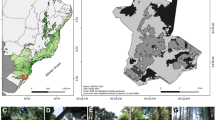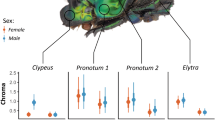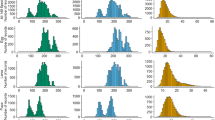Abstract
The presence of annual and biennial individuals within the same population has been recently demonstrated in the myrmecophilous butterflies Maculinea rebeli and Maculinea alcon, which present a cuckoo strategy inside Myrmica nests, and Maculinea arion which is a predatory species. Here, we present field and laboratory data on polymorphic larval growth in two other predatory species of Maculinea: M. teleius and M. nausithous. Body mass distributions of pre-pupation larvae were bimodal in both species. These results point to the existence of larvae that develop in 1 or 2 years. We also showed that the probability of pupation depended on larval body mass. In the case of M. teleius, the critical body mass at which larvae have a 50% probability of pupation is about 80 mg. We suggest that polymorphism in Maculinea may have evolved as an adaptation to life in ant nests, a habitat which protects them from predators and provides food. However, the quality of this resource is highly variable and unpredictable. According to the bet-hedging hypothesis, if the habitat is unpredictable, females should have an advantage by producing more variable offspring. In the case of Maculinea butterflies, this may involve maintaining larvae that develop in 1 or 2 years.



Similar content being viewed by others
References
Als TD, Vila R, Kandul NP, Nash DR, Yen SH, Mignault AA, Boomsma JJ, Pierce NE (2004) The evolution of alternative parasitic life histories in large blue butterflies. Nature, DOI 10.1038/nature03020
Elmes GW, Wardlaw JC (1981) The quantity and quality of overwintered larvae in five species of Myrmica (Hymenoptera: Formicidae). J Zool 193:429–446
Elmes GW, Wardlaw JC, Thomas JA (1991) Larvae of Maculinea rebeli, a large blue butterfly, and their Myrmica host ants: wild adoption and behaviour in ant-nests. J Zool 223:447–460
Elmes GW, Thomas JA, Wardlaw JC, Hochberg ME, Clarke RT, Simcox DJ (1998) The ecology of Myrmica ants in relation to the conservation of Maculinea butterflies. J Insect Conserv 2:67–78
Elmes GW, Barr B, Thomas JA, Clark RT (1999) Extreme host specificity by Microdon mutabilis (Diptera: Syrphidae), a social parasite of ants. Proc R Soc Lond B 266:447–453
Fiedler K (1990) New information on the biology Maculinea nausithous and M. teleius (Lepidoptera: Lycaenidae). Nota Lepidopt 12:246–256
Fiedler K (1991) Systematic, evolutionary, and ecological implication of myrmecophily within the Lycaenidae (Insecta: Lepidoptera: Papillionidea). Bonn Zool Monogr 31:5–210
Figurny E, Woyciechowski M (1998) Flowerhead selection for oviposition by females of the sympatric butterfly species Maculinea teleius and M. nausithous (Lepidoptera: Lycaenidae). Entomol Gener 23:215–222
Gross MR (1985) Disruptive selection for alternative life histories in salmon. Nature 313:47–48
Hovestadt T, Mitesser O, Elmes G, Thomas J, Hochberg M (2005) Ass ESS model for evolution of growth polymorphism in the social parasite Maculinea rebeli. In: Study in the ecology and conservation of butterflies in Europe, vol 2. Species ecology along a European Gradient: Maculinea butterflies as a model. Pensoft, Sofia, pp 126–127
Macdonald PDM (1980) A Fortran programme for analyzing distribution mixtures. Statistical technical report 80-ST-1. McMaster University, Ontario
Nowicki P, Witek M, Skórka P, Settele J, Woyciechowski M (2005) Population ecology of the endangered butterflies Maculinea teleius and M. nausithous, and its implications for conservation. Popul Ecol, DOI 10.1007/s10144–005–0222–3
Schönrogge K, Wardlaw JC, Thomas JA, Elmes GW (2000) Polymorphic growth rates in myrmecophilous insects. Proc R Soc Lond B 267:771–777
Skórka P, Witek M, Woyciechowski M (2006) A simple and nondestructive methods for estimation of worker population size in Myrmica ant nests. Insects Soc 53:97–100
Sliwinska EB, Nowicki P, Nash DR, Witek M, Settele J, Woyciechowski M (2006) Morphology of caterpillars and pupae of European Maculinea species (Lepidoptera: Lycaenidae) with identification table. Entomol Fenn (in press)
StatSoft (2003) Statistica electronic manual, version 6. StatSoft, Tulsa, Okla.
Stearns SC (1992) The evolution of life histories. Oxford University Press, Oxford
Thomas JA, Wardlaw JC (1992) The capacity of a Myrmica ant nest to support a predacious species of Maculinea rebeli inhabitants in ant nests. Oecologia 91:101–109
Thomas JA, Elmes GW (1998) Higher productivity at the cost of increased host-specificity when Maculinea butterfly larvae exploit ant colonies through trophallaxis rather than by predation. Ecol Entomol 23:457–464
Thomas JA, Elmes GW, Wardlaw JC (1998a) Polymorphic growth in larvae of the butterfly Maculinea rebeli, a social parasite of Myrmica ant colonies. Proc R Soc Lond B 265:1895–1901
Thomas JA, Clark RT, Elmes GW, Hochberg ME (1998b) Population dynamics in the genus Maculinea (Lepidoptera: Lycaenidae). In: Dempster JP, McLean IFG (eds) Insect population dynamics: in theory and pratice. Chapman & Hall, London, pp 261–290
Wardlaw JC (1991) Techniques for rearing Myrmica ants (Hym.) and Maculinea rebeli Hir. caterpillars. Entomol Mon Mag 127:233–241
Wardlaw JC, Elmes GW (1996) Exceptional colony size in Myrmica species (Hymenoptera: Formicidae). Entomologist 115:191–196
Wardlaw JC, Elmes GW, Thomas JA (1998) Techniques for studying Maculinea butterflies. I. Rearing Maculinea caterpillars with Myrmica ants in the laboratory. J Insect Conserv 2:79–84
Acknowledgements
We would like to thank Karsten Schönrogge for his help with Macdonald’s optimisation routine analysis. Anna Amirowicz, Marta Wantuch and Kajetan Woyciechowski kindly assisted us with the fieldwork. Two anonymous reviewers provided helpful comments on an earlier version of the manuscript. Specimens were collected with permission of the Polish Ministry of Environment. This study was financed by the EC within its RTD project EVK2-CT-2001-00126 as well as by the Polish Committee of Scientific Research by its grant SPUB-3024.
Author information
Authors and Affiliations
Corresponding author
Additional information
Communicated by Konrad Fiedler
Rights and permissions
About this article
Cite this article
Witek, M., Sliwinska, E.B., Skórka, P. et al. Polymorphic growth in larvae of Maculinea butterflies, as an example of biennialism in myrmecophilous insects. Oecologia 148, 729–733 (2006). https://doi.org/10.1007/s00442-006-0404-5
Received:
Accepted:
Published:
Issue Date:
DOI: https://doi.org/10.1007/s00442-006-0404-5




